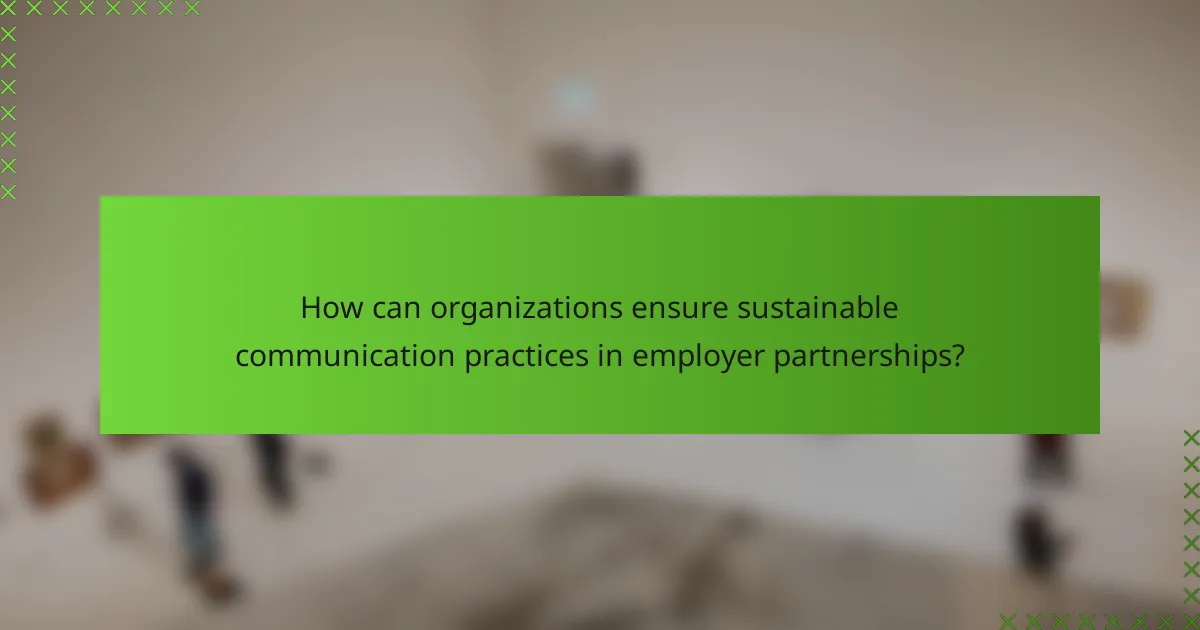
What are the best practices for communication in employer partnerships for business apprenticeships?
Effective communication in employer partnerships for business apprenticeships involves establishing clear expectations. Regular check-ins between employers and apprenticeship coordinators ensure alignment on goals. Utilizing collaborative tools, such as shared digital platforms, enhances transparency and accessibility. Providing structured feedback mechanisms allows for continuous improvement in the apprenticeship experience. Active listening during discussions fosters trust and understanding among partners. Additionally, documenting all communications helps maintain a clear record of agreements and changes. Research indicates that partnerships with strong communication practices yield higher satisfaction rates among apprentices and employers.
How can effective communication enhance employer partnerships?
Effective communication enhances employer partnerships by fostering trust and collaboration. Clear communication allows both parties to articulate expectations and goals. It reduces misunderstandings and aligns objectives. Regular updates and feedback create a transparent environment. This transparency strengthens relationships and encourages problem-solving. Studies show that organizations with strong communication practices have higher employee engagement. Engaged employees contribute positively to partnerships and overall success. Effective communication also facilitates knowledge sharing, leading to innovative solutions. Therefore, it is essential for sustainable employer partnerships in business apprenticeships.
What are the key elements of effective communication in this context?
The key elements of effective communication in employer partnerships for business apprenticeships include clarity, active listening, and feedback. Clarity ensures that messages are straightforward and easily understood. This prevents misunderstandings and aligns expectations between parties. Active listening involves fully concentrating on the speaker, which fosters mutual respect and understanding. It encourages open dialogue and builds trust. Feedback is essential for continuous improvement. Providing constructive feedback helps refine processes and enhances collaboration. Together, these elements create a strong foundation for successful partnerships in apprenticeship programs.
How does communication impact the success of business apprenticeships?
Effective communication significantly impacts the success of business apprenticeships. Clear communication establishes expectations between employers and apprentices. It fosters a supportive learning environment. Regular feedback helps apprentices understand their progress. Open dialogue encourages apprentices to ask questions and seek guidance. Studies show that effective communication increases retention rates among apprentices. For instance, a report by the National Apprenticeship Service indicates that businesses with strong communication practices see a 20% higher completion rate in apprenticeship programs. This demonstrates that communication is crucial for both skill development and overall apprenticeship success.
What techniques can be employed to improve communication in employer partnerships?
Employing regular check-ins is a technique to improve communication in employer partnerships. These meetings facilitate open dialogue and address concerns promptly. Utilizing collaborative tools enhances transparency and keeps all parties informed. For instance, project management software can streamline communication and task assignments. Establishing clear expectations upfront helps align goals and reduces misunderstandings. Providing training on effective communication techniques can empower team members. Encouraging feedback fosters a culture of continuous improvement. Lastly, celebrating successes together strengthens relationships and enhances collaboration.
How can active listening be utilized in these partnerships?
Active listening can be utilized in employer partnerships for business apprenticeships to enhance communication and collaboration. This technique involves fully concentrating, understanding, and responding thoughtfully to the speaker. By practicing active listening, partners can clarify expectations and address concerns effectively. It fosters a supportive environment, encouraging open dialogue. Research shows that organizations with strong communication practices see a 25% increase in employee engagement. This engagement leads to better apprenticeship outcomes and overall partnership success. Therefore, integrating active listening into these partnerships is essential for achieving mutual goals.
What role does feedback play in effective communication?
Feedback is essential in effective communication as it ensures clarity and understanding between parties. It allows individuals to gauge whether their message has been received as intended. Feedback can take many forms, including verbal responses, written comments, or non-verbal cues. This interaction helps to identify misunderstandings or areas for improvement. Research indicates that regular feedback in communication enhances engagement and collaboration. For instance, a study by Stone and Heen (2014) in “Thanks for the Feedback” highlights that constructive feedback leads to better performance and stronger relationships. Thus, feedback serves as a critical component in refining communication processes.
What tools are available to facilitate communication in employer partnerships?
Communication tools available for employer partnerships include project management software, video conferencing platforms, and instant messaging applications. Project management software like Trello or Asana helps organize tasks and timelines. Video conferencing platforms such as Zoom or Microsoft Teams enable face-to-face discussions, enhancing clarity and engagement. Instant messaging applications like Slack facilitate quick communication and information sharing. These tools streamline collaboration and improve relationship management between employers and apprentices. They are widely used in various industries, confirming their effectiveness in enhancing communication.
What digital platforms can support communication efforts?
Digital platforms that can support communication efforts include email, social media, and video conferencing tools. Email allows for direct and formal communication. Social media platforms like LinkedIn facilitate networking and sharing updates. Video conferencing tools such as Zoom enable real-time discussions and presentations. Collaboration tools like Slack enhance team communication and project management. Project management software like Trello organizes tasks and deadlines. These platforms are widely used in professional settings, proving their effectiveness in facilitating communication.
How can project management tools enhance collaboration?
Project management tools enhance collaboration by providing centralized platforms for team communication and task management. These tools facilitate real-time updates, ensuring all team members are informed about project progress. They allow for document sharing, which streamlines access to necessary resources. Additionally, project management tools often include features like task assignments and deadlines, promoting accountability among team members. They can integrate with other applications, improving workflow efficiency. According to a study by the Project Management Institute, effective use of project management tools can increase project success rates by up to 40%. This highlights their role in fostering better collaboration within teams.

What strategies can be implemented for successful employer partnerships?
Successful employer partnerships can be achieved through clear communication and mutual goals. Establishing regular meetings fosters transparency and alignment. Creating shared objectives ensures both parties are working towards common outcomes. Utilizing technology for updates streamlines information sharing. Implementing feedback mechanisms allows for continuous improvement. Providing training opportunities enhances skills relevant to the partnership. Building trust through accountability strengthens the relationship. Lastly, celebrating achievements reinforces commitment and motivation.
How can clear objectives improve communication in partnerships?
Clear objectives enhance communication in partnerships by providing a shared understanding of goals. When partners know what they aim to achieve, discussions become more focused and productive. Clear objectives reduce ambiguity, leading to fewer misunderstandings. This clarity fosters accountability, as each partner knows their responsibilities. Research indicates that well-defined goals can increase team performance by up to 20%. Additionally, clear objectives facilitate timely feedback, allowing partners to adjust strategies effectively. Overall, clear objectives streamline interactions and improve collaboration outcomes.
What methods can be used to set and communicate these objectives?
Methods to set and communicate objectives include SMART criteria, stakeholder meetings, and regular updates. SMART criteria ensure objectives are Specific, Measurable, Achievable, Relevant, and Time-bound. Stakeholder meetings facilitate collaborative goal-setting and ensure alignment among partners. Regular updates maintain transparency and allow for adjustments based on feedback. These methods enhance clarity and engagement in apprenticeship initiatives.
How does alignment of goals benefit the partnership?
Alignment of goals strengthens partnerships by ensuring all parties work towards a common objective. This unity fosters collaboration and enhances communication among partners. When goals are aligned, resources can be allocated more efficiently. This leads to improved project outcomes and higher satisfaction for all stakeholders. Research shows that organizations with aligned goals experience a 20% increase in productivity. Thus, goal alignment is crucial for maximizing the effectiveness of partnerships.
What are the common challenges in communication within employer partnerships?
Common challenges in communication within employer partnerships include misalignment of goals, differing communication styles, and lack of clarity. Misalignment occurs when employers and partners have different expectations for outcomes. Differing communication styles can lead to misunderstandings and frustration. Lack of clarity in roles and responsibilities complicates collaboration. Additionally, cultural differences may affect communication dynamics. Time constraints can hinder effective communication as well. These challenges can create barriers to successful partnerships. Addressing these issues is essential for effective collaboration in business apprenticeships.
How can misunderstandings be minimized?
Misunderstandings can be minimized through clear communication. Establishing open dialogue encourages sharing of thoughts and concerns. Active listening ensures all parties understand each other’s perspectives. Using simple, straightforward language avoids confusion. Regular check-ins can clarify expectations and progress. Documenting agreements provides a reference point for all involved. Training in communication skills enhances overall effectiveness. Research shows that effective communication reduces conflicts and improves relationships.
What strategies can address communication barriers?
Strategies to address communication barriers include active listening, simplifying language, and using visual aids. Active listening ensures understanding by encouraging feedback and clarification. Simplifying language reduces complexity and avoids jargon, making it accessible. Visual aids like charts or graphs enhance comprehension by providing clear references. Additionally, fostering an inclusive environment promotes open dialogue. Employing technology tools, such as translation apps, bridges language gaps. Regular training on communication skills improves overall effectiveness. Research indicates that effective communication enhances collaboration and productivity in workplace settings.

How can organizations ensure sustainable communication practices in employer partnerships?
Organizations can ensure sustainable communication practices in employer partnerships by establishing clear communication channels. Regular meetings should be scheduled to discuss progress and challenges. Feedback mechanisms must be implemented to gather insights from all stakeholders. Transparency in sharing information fosters trust and collaboration. Training sessions can enhance communication skills among team members. Utilizing digital tools can streamline communication processes and documentation. Setting measurable goals for communication effectiveness can help track progress. Research indicates that organizations with structured communication strategies see improved partnership outcomes.
What ongoing training can support effective communication skills?
Ongoing training that can support effective communication skills includes workshops, seminars, and online courses. These formats provide structured learning environments. Workshops often focus on practical exercises and role-playing scenarios. Seminars can cover advanced topics and facilitate discussions among peers. Online courses offer flexibility and diverse content options. Regular feedback sessions are also beneficial for skill enhancement. According to a study by the National Communication Association, continuous training improves communication effectiveness in professional settings. This evidence supports the importance of ongoing training for developing communication skills.
How can organizations measure the effectiveness of their communication strategies?
Organizations can measure the effectiveness of their communication strategies through various metrics. They can utilize employee surveys to gather feedback on clarity and understanding. Tracking engagement levels on communication platforms provides insights into reach and impact. Analyzing response times to inquiries can indicate the efficiency of communication. Monitoring attendance at meetings or events reflects interest and engagement. Reviewing the quality of feedback received can highlight areas for improvement. Additionally, assessing changes in employee performance or satisfaction can correlate with communication efforts. These methods collectively offer a comprehensive view of communication effectiveness.
What are the best practices for maintaining long-term communication in partnerships?
Establishing regular check-ins is a best practice for maintaining long-term communication in partnerships. These meetings foster open dialogue and ensure alignment on goals. Utilizing collaborative tools enhances transparency and accessibility of information. Setting clear expectations helps prevent misunderstandings and keeps all parties accountable. Active listening is crucial; it shows respect and encourages feedback. Documenting discussions and decisions helps maintain a clear record for future reference. Encouraging informal interactions can strengthen personal relationships and build trust. Finally, being adaptable to changes in circumstances ensures that communication remains effective over time.
How can regular check-ins improve relationship management?
Regular check-ins can significantly enhance relationship management by fostering open communication and trust. These interactions provide opportunities for feedback and clarification on expectations. They help identify and address issues before they escalate. Regular check-ins also promote accountability among partners. Research indicates that businesses with consistent communication practices report higher satisfaction levels. According to a study by the Harvard Business Review, effective communication can lead to a 25% increase in productivity. This demonstrates the value of regular check-ins in maintaining strong and effective partnerships.
What role does transparency play in sustaining partnerships?
Transparency is crucial in sustaining partnerships as it fosters trust and accountability. When partners openly share information, it reduces misunderstandings and aligns expectations. According to a study by the Project Management Institute, 80% of project success is attributed to effective communication. Transparency also encourages collaboration, enabling partners to address issues proactively. Furthermore, it enhances decision-making by providing all stakeholders with relevant insights. Ultimately, transparency solidifies relationships, making them more resilient to challenges.
What practical tips can enhance communication in employer partnerships for business apprenticeships?
Establishing regular communication channels enhances employer partnerships for business apprenticeships. Schedule consistent meetings to discuss progress and challenges. Use collaborative tools like project management software to streamline information sharing. Encourage feedback from both apprentices and employers to identify areas for improvement. Clearly define roles and responsibilities to minimize misunderstandings. Provide training on effective communication strategies for all parties involved. Document discussions and decisions to ensure accountability and transparency. Foster a culture of open communication to strengthen relationships and collaboration.
The main entity of the article is effective communication in employer partnerships for business apprenticeships. The article outlines best practices, techniques, tools, and strategies that enhance communication between employers and apprenticeship coordinators. Key topics include establishing clear expectations, the importance of regular check-ins and feedback, the role of active listening, and the use of digital platforms and project management tools to facilitate collaboration. Additionally, it addresses common communication challenges and offers practical tips for maintaining long-term relationships and ensuring successful apprenticeship outcomes.